Abstract
Periodic daily fluctuating demand for energy and power is a perceptible phenomenon, resulting in some moments of low demand for power and energy related to the huge energy comes from renewable energy systems, and some moments of peak load demand. This phenomenon, when combined with the non-stationary operation of huge capacity of renewable energy systems, results in no stability of voltage and frequency. To assure continuous network stability and to avoid energy losses from renewable energy systems that are subject to such control system, a hybrid system with energy–power storage in the form of pumped-hydro storage is considered the most suitable technically. This paper presents the design, modeling, analysis, and feasibility study of a hybrid wind and water-pumping storage system. The system was designed and analyzed for King Talal Dam (KTD), which is in Northern Jordan. The importance of this study is that it is directed mainly to Jordan and the Middle East and North Africa (MENA) region in general. The Jordanian renewable energy market is a promising arena that encourages developers, investors, engineers, and companies to develop and install pure renewable energy systems and renewable energy hybrid projects for the generation of electricity. The analysis of wind data is carried out using the “windfarm” software with 5.16 m/s as average wind speed. It is followed by the design of the hybrid system, which is simulated for a daily operation of 2–3 h as peak load hours. Based on the technical outcomes, cost study and feasibility analyses are carried out with Jordanian market prices. The total estimated annual energy production is 26,663,933 kWh from 10 MW wind farm and 5.2 MW pumping storage system. The aforementioned studies showed that a similar hybrid system is not always fully commercially feasible. However, a pure pumped-storage system proved to be technically feasible and assisting the grid. The whole project analysis determines that such a system boosts the operational stability of the grid, increases the penetration of renewable energy systems and reduces the energy import. In addition, 15,100,000 tons of CO2-equivalent is estimated as annual emissions reduction in this study.
1. Introduction
The increased use of renewable energy systems worldwide during recent decades has caused saturation in some local electrical grids. The primary cause of this saturation is the intermittent nature of the electrical power produced by these technologies and the subsequent stability issues that the grid operators are faced with, along with the ever-increasing demand for the application of green technologies mainly by public sectors and private local and international investors.
An efficient method of energy storage is achieved by transferring quantities of water from a lower body of water to a higher elevation by converting it to potential energy and by using it later to regenerate electricity. Energy transformations require the use of pumps and hydraulic turbines to complete the cycle. Renewable energy systems come into play by providing their electrical output to the pumping stations instead of feeding them directly to the grid, thus avoiding the negative effects on network stability.
1.1. Energy Situation in Jordan
The impacts of climate change on Jordan are serious and pervasive. They form a threat to the country’s population. Besides the rapid population growth, water resources in the country are scarce; therefore, the impacts of climate change are likely to further aggravate [1]. Jordan faces potentially dangerous effects on its natural ecosystems, on its watersheds, and on biodiversity. This issue then cascades to impacts on food productivity, water resources, human health, public infrastructure, and human settlements. Jordan recognizes the magnitude of these harmful impacts caused mainly by its energy sector, yet it has very limited primary energy resources and imports 95% of the required energy.
Securing energy supply and diversifying the energy sources is one of the main objectives of energy strategy in Jordan. Jordan is committed to increasing the share of renewable energies to 10% in 2020; the major share of renewable energy systems is to come from wind power (800 MW) and solar power (800 MW) in addition to 30–50 MW from the conversion of waste to energy. Concurrently, the Ministry of Energy and Mineral Resources and the National Electric Power Company (NEPCO) are committed to adapt the electricity network to the challenges of both increasing electricity quantities and fluctuating input from renewable energy [2].
1.2. Pumped-Hydro Storage Technology
Pumped storage is recently viewed as the most promising technology to increase renewable energy penetration levels in power systems and particularly in small autonomous island grids [3]. The characteristic of flexible generation in pumped-hydro energy storage can provide both up and down regulation in the power system while its quick start capabilities make it suitable for black starts and provision of spinning and standing reserve.
Taking into consideration the absence of data in the literature on new pumped-hydro energy storage-plant development, Deane et al. in [4] review the current trends in the technology based on publicly available information from utilities, government bodies, and electricity regulators in the European region. According to the authors, Current trends for new pumped-hydro energy storage development generally show that developers operating in liberalized markets are tending to repower, enhance projects or build “pump-back” pumped-hydro energy storage rather than traditional “pure pumped storage”.
Ibrahim et al. In [5] highlight the urgency and importance of storing energy for strengthening power grids and maintaining load levels. Multiple types of storage methods are compared, and pumped hydropower storage was found to be the most used for high-power applications. Pumped hydroelectric systems have conversion efficiency, from the point of view of a power network, of about 65–80%, depending on equipment characteristics. However, the main disadvantage of this technology is the site requirements.
On the worldwide scale, there are more than 300 pumped-hydro energy storage installations with a total capacity of 127 GW [6]. According to the energy information administration, official energy statistics from the US government in 2008 the USA has an installed capacity of 21,886 MW of pumped-hydro energy storage plants accounting for 2.1% of its total installed generating capacity [7].
Japan currently has 34 large-scale pumped-hydro energy storage plants with a total capacity of 24,575 MW [8], which accounts for 10.2% of its full installed generating capacity. The Japanese pumped-hydro energy storage revolution accompanied the nuclear power revolution as pumped-hydro energy storage could provide support for the nuclear generating plants during peak demand.
Most pumped-hydro energy storage plants in the European region are found in Germany, France, Switzerland, and Austria. Germany has the largest number of pumped-hydro energy storage plants (23 operational plants ranging in capacity from 62.5 to 1060 MW) [3]. The largest plant in the region is the 1800 MW EDF owned “Grand Maison” facility in the French Alps [3].
1.3. Hybrid Wind-Powered Pumped-Hydro Energy Storage
Increasing interest in the hybrid wind electric generation with pumped-hydro energy storage systems is evident through recent publications in the field studying the technological, environmental, and economic aspects of such projects. In [9], the pump and the pipe storage system is thoroughly studied in addition to the possible structure of the system under the condition of variable wind energy as an electric power source in order to determine the challenges and obstacles to compose a grid connected wind-hydro-pumped storage station. Obstacles such as control and dispatch of the system consisting of wind turbines and pumps when connected to the grid, stability of system, and proper allocation (capacity ratio) and efficiency of each system component were studied focusing on discussing the power balance in the grid connected system. It was found that the biggest challenge for power balance in a wind driven pump storage system is whether or not the power regulation range of pumps may cover the fluctuation range of wind energy for a given head lift and a certain flow.
Li et al. in [10] proposed a method to design wind-solar hybrid power supply system with pumped storage to replace the use of batteries in order to overcome the combined shortage in wind-solar hybrid system power generation and electricity load’s imbalance due to uncertainty of resources. According to the authors, the method proposed can produce a reasonable configuration for the system capacity according to the user’s electricity load and resource condition and can ensure system reliability of power supply and reduce the cost of the power generation system.
Juan I. Pérez-Díaz et al. in [11] investigated the contribution of pumped-hydro energy storage to the operation of electric system with high wind penetration with the help of a weekly optimal operation-scheduling model. The system was based on programming to get the optimal hourly thermal, hydro, and pumping powers for minimizing the production cost of the system. The system operation was studied under different demand and wind speed scenarios to scale the system according to different wind penetration levels. It was concluded that pumped-storage plants contribute in all cases analyzed to the reduction of the system operation costs, the magnitude of the reduction increased as the level of wind power penetration increases.
Regarding the technology of wind farms, authors in [12,13] fully investigates the trends of wind energy technologies. Outcomes of this study showed that within the next two-three decades the vertical axis wind turbine is expected to dominate the field as it requires less land space and can produce higher energy. They also forecasted that the demand for energy storage systems combined with wind farms will rise highly. Many areas, however, still require technological upgrading for the reduction of its cost.
The authors in [14] discuss the importance of carrying out performance forecasts for renewable energy systems to maximize the resultant benefits and to keep the reliability indicators at the required level. Additionally, recent developments in the forecasting and management fields provide essential means for manage renewable energy projects. The publication also indicates that storage units should be used when the level of renewable energy projects integrated in the power system becomes significant. The adoption of probabilistic approaches for energy forecasts is said to aid in setting correct storage requirements leading to economic dispatch with higher success.
Multiple recent studies were focused on the prospects of hybrid wind generations systems with pumped-hydro energy storage [15,16,17,18,19,20,21,22]. Those studies were distributed in different areas of the globe; however, most of them were focused on integrating this type of system into autonomous grid systems in remote islands.
Research paper [15] analyzes the configuration and operation principles of hybrid wind-hydropower plants with pumped storage integrated into autonomous electric grid systems to support high wind energy penetration. This research used a computer algorithm for the detailed simulation and analysis of a plant installed in the autonomous power system of the Greek island of Crete. The purpose of the simulation was to study the effect of some main design parameters on the plant energy results such as the reservoir capacity and the wind farm power and to find possible optimum options of the system. The results showed that a hybrid plant with the new operation strategy is able to effectively substitute a significant portion of both installed power and electricity production of the conventional fossil-fuel plants on the island.
In [16], Bueno and Carta propose the installation of an appropriately administered wind-powered pumped-hydro storage system in the Canary Islands to overcome the stability and safety restrictions of the island’s electrical system. The results obtained from the application of an optimum-sized economic model of such a system indicate that penetration of renewable sourced energy can be increased by 1.93% (52.55 GW h/year) at a competitive cost for the unit energy supplied. Investment, operating, and maintenance costs are taken into account, as well as those costs involving health and environmental damage associated with energy production and use (externalities).
For the Greek Island of Ikaria, the first of its kind, a wind-powered pumped-hydro storage station was presented in [17]. The project is designed to exploit the hydroelectric potential of an existing water reservoir at high elevation, along with the energy produced by a new wind farm, via pumped-storage operation. In this paper, the plant is described and a suitable operating policy is introduced, both for the wind-powered pumped-hydro storage systems and the overall generation system of Ikaria, taking into consideration the existing regulatory framework for such installations. According to the authors, the plant achieves smooth integration, without adverse effects on the operation of the conventional generation and other Renewable Energy Systems (RES) stations on the island. The studied project results in a substantial increase of renewable energies penetration in the energy equilibrium of the island, which may exceed 50% on an annual basis. Additionally, the plant exploits in a very efficient manner the wind and hydro potential and can provide firm capacity to the island’s electrical system, substituting expensive conventional peak units.
Kapsali et al. provide a complete sensitivity analysis based on economic perspectives on wind-powered pumped-hydro storage systems for remote islands in [18]. It was concluded that under certain conditions, wind-powered pumped-hydro storage systems may considerably contribute to the reduction of the current high energy production costs, by taking advantage of the wind potential in areas with considerable wind potential. Furthermore, this system is said to constitute a solution to the problem of the restricted wind energy contribution due to its high intermittency. Finally, the socio-economic benefits of such systems were found to be significant starting with the contribution to regional development by creating local job opportunities and the reduction of harmful emissions related with the fossil-fuel combustion.
In Ireland [19], a literature explored how large-scale storage provided aid for the integration on intermittent renewable energy systems. A similar case study of using a wind power plant in combination with pumped-hydro storage was the primary area of the investigation. In total three key features of the pumped-hydro storage systems were investigated: its operation, size, and cost. From the results it was evident that pumped-hydro storage systems can increase the wind penetration feasible on the Irish energy system and reduce its operating costs. However, further feasibility investigation is encouraged as fuel prices, interest rates, and annual electricity production from wind may highly vary from year to year. Some publications in the area of hybrid renewable energy systems demonstrate the popularity of this area in technical research. However, the cost of these technologies remains relatively high [20].
In Ethiopia, Tana Beles is one of the largest hydropower plants. The plant’s sustainability is threatened by the water level of Laka Tana. Due to changes in the climate and natural flow of the level of the lake, especially during dry seasons, the lake almost decreases by half. This variability makes the power plant less efficient than the designed goal. To address that issue, Tilahun in [21] proposes a pumped-storage system with six reversible pump/turbines. As proved from the study, a hybrid system is not feasible but a pure pumped-storage system is.
Tilahun [21] inspected and compared two popular energy storage technologies; batteries and pumped hydroelectric storage. Both technologies were studied on the renewable energy powered micro-grid system on a remote island in Hong Kong. The two storage schemes were further divided into 4 options. Accordingly, the lifecycle costs (LCC), levelized costs for the renewable energy storage system and the LCC ratios between all options were calculated and compared. The economic advantage of pumped showed the lowest LCC among all options at 29–48% of the pure battery storage system LCC. Sensitivity analysis also revealed that pure hydro storage is even more cost competitive by controlling some adjustments such as increasing energy storage capacity and days of autonomy. Therefore, the renewable energy system coupled with pumped storage proved to be technically feasible [22].
In the current paper, a state-of-the-art water pumped-storage solution for reducing the negative effects of the penetration of renewable energy generators into the Jordanian electric grid is the core of this paper. For this purpose, a hybrid wind–hydro plant with water pumped storage was designed, studied, thoroughly investigated, and described using the existing hydropower station in the King Talal Dam in the north of Jordan. The importance of this study is that it is directed mainly to Jordan and the Middle East and North Africa (MENA) region in general. The Jordanian renewable energy market is a promising arena that encourages developers, investors, engineers and companies to develop and install pure renewable energy systems and renewable energy hybrid projects for the generation of electricity. Currently, researchers, designers, developers, ministries of energy, regulators and electrical companies around the world are intensifying their efforts in solving this problem of grid saturation especially in countries with small installed network capacities, such as Jordan. Most efforts in current research for solving this issue are heading towards finding efficient means of energy storage. Furthermore, Jordan has received a large influx of refugees from neighboring countries and more recently from Syria. About 1.3 million refugees are adding more challenges on the country’s economy and infrastructure and has put pressure on all sectors including water, municipal services and electricity supply [23,24]. Moreover, the CO2-emissions reduction from the operation of this system is considered to be an important factor as the proposed site is located near an ancient historical roman city called Jerash on of the Ten Decapolis Cities.
2. Description of the Site
2.1. Dams in Jordan
Jordan is a naturally water scarce country. Its climate ranges from semi-arid in the north-western part of the country to arid desert in its eastern and southern parts. Jordan is subjected to periodic droughts; water supply from surface sources has declined substantially over recent years leading the country’s development plans to prioritize dam construction throughout the country.
Multiple large-scale dams are in the northern and southern parts of Jordan. Fortunately, most of the existing dams are surrounded by mountains and hills with significant heights that are promising for implementing the pumped-hydro energy storage system proposed in this paper. Dams in Jordan are generally being used for irrigation mainly in addition to hydropower generation, ground water recharge, drinking water production, and industrial purposes.
2.2. King Talal Dam
King Talal Dam (KTD) is a large-scale dam in the hills of Northern Jordan. KTD forms a large reservoir in Wadi Zarqa, Jordan’s second-largest river. The dam construction started in 1971 and its original construction was completed in 1977. The dam later went through addition construction in the 1980s to increase the capacity of its reservoir [25].
The dam currently plays a small role in protecting the water level or ecosystems of Wadi Zarqa. However, the irrigation water drawn from it enables many thousands of people in the Jordan Valley to make a living through agriculture and provides renewable hydroelectric energy [25]. Figure 1 shows a KTD and the landscape around.
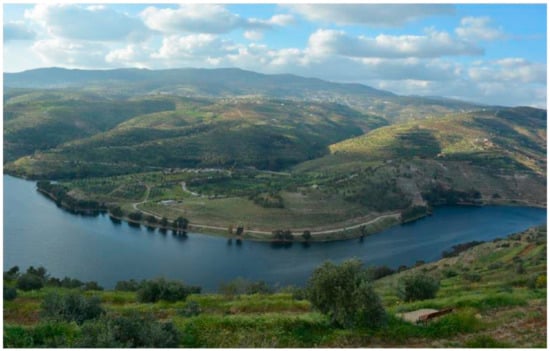
Figure 1.
King Talal Dam area.
Table 1 lists the characteristics of the dam’s body, its lake in addition to the hydrology.

Table 1.
King Talal Dam’s Characteristics [25].
The meteorological mast was installed by National Energy Research Center, [26] in Um Al-Rumman and it is located within the latitude and longitude of 32°10′56.0″ N 35°49′36.1″ E respectively, just 1 km off the KTD area. The data was recorded from July 1, 2007 until June 30, 2008, and its sampling rate was one sample per second. The data acquisition system, on the other hand, calculates 10 min average, minimum, maximum, and standard deviation for each sensor
Water-Pumping Subsystem Location and Layout
The technical data and the parameters of the pumping station are: Nominal total input power 5.2 MW, consists of two parallel pumps, nominal power of each pump is 2.6 MW and they both have the capability to operate as generators and pumps. The pumping station powerhouse room is of adequate surface to accommodate all the mechanical and electrical equipment necessary for the proper operation of the pumping process. Furthermore, inside the pumping station there is several piping sections such as manifolds, pumps water inlet and discharge pipes, electrical motors driving the pumps, electrical panels, and cable conduits as well as several auxiliaries. Figure 2 shows the layout of the of the wind farm connected with the hydropower plant at KTD.
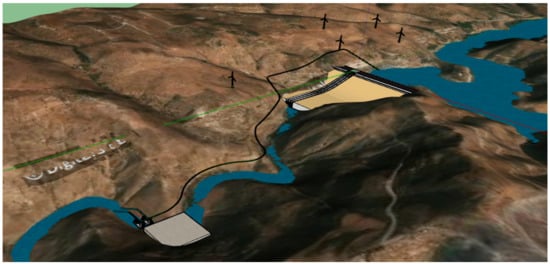
Figure 2.
Layout of the of the wind farm connected with the hydropower plant at KTD.
3. Methodology
3.1. Simulation Software
3.1.1. Model Description
In this study, the WindFarm Simulation software is used [27], the model is based on a division of an assumed neutrally stratified flow field into inner and outer layers. The outer layer is characterized by inviscid, potential flow, while in the inner layer, a balance between adjective, pressure-gradient and turbulent-viscous forces is assumed, and turbulent transfers are modeled with a simple mixing length closure scheme. Fourier transforms are used to provide the solution. The wind profile is modeled during the wind distribution calculation in the WindFarm Software, which is considered to be a vital model in the wind flow simulation.
The following data are required to calculate the energy yield of a wind farm:
- Wind distribution data–A wind rose representing the wind farm site at a specific point including wind profile and turbulence information.
- Wind turbine data–Geometry along with power and thrust data versus wind speed.
- Topographic data–A representation of the topography (which includes both height and roughness data) of the wind farm site and its surroundings.
The topographic, turbine, wind and wake data are brought together to calculate the yield of a wind farm as the sum of individual calculations around the compass. Typically, 60 steps (or every 6°) have been found to be sufficient to achieve accurate predictions. Further description of the wind farm simulation was discussed by the authors [28].
3.1.2. Implemented Mathematical Equations and Correlations
The power of the movements of winds can be described by a defined mass of air , flowing through the swept area of the rotor with the velocity given by the Equations (1)–(3) [29]:
The kinetic power of the mass of air is given by the expression
where;
- is the power produced by the Pelton hydraulic turbines, KW
- the air density, kg/m3
- is the air mass flow rate, kg/sec
- is the wind speed, m/sec
- is the swept area, m2
The conversion of the kinetic power in the wind is subject to aerodynamic losses as the air passes through the rotor. Those losses are valued by a coefficient to account for the conversion losses of energy. The power coefficient can be obtained from manufacturer data where, apart from the aerodynamic behavior of the blades, the mechanical and electrical losses are considered. The power coefficient can be obtained from manufacturer data where, apart from the aerodynamic behavior of the blades, the mechanical and electrical losses are considered. Therefore, the kinetic power becomes:
where;
- is the aerodynamic capacity factor (wind power fraction captured by the wind turbine).
The wind turbines implemented in this study were of the type Vestas V90-2.0 MW. Vestas V90-2.0 MW wind turbine is a pitch regulated upwind turbine with active yaw and a three-blade rotor. The Vestas V90-2.0 MW turbine has a rotor diameter of 90 m with a generator rated at 2.0 MW, depending on wind conditions. The turbine uses a microprocessor pitch control system called OptiTip and the OptiSpeed (variable speed) feature. With these features, the wind turbine can operate the rotor at variable speed (rpm), helping to maintain the output at or near rated power.
Wind turbine manufacturers are the source of the power and thrust information for any selected wind turbine. Thrust data are given in kilo Newtons (kN) or as thrust coefficient , which is the normalized force, is related to the thrust force by the relationship:
WindFarm Simulation software can calculate the energy yield of a wind farm, including topographic and wake effects, optimizing the turbine layout for maximum energy yield. We then perform noise calculations (showing the noise contours), analyze wind turbine data, create zone-of-visual-influence maps, display wire frame views of wind farms, calculate shadow flicker, and create 3D visualizations. Also, the model performs measure-correlate-predict analysis of wind speed data and deals with the correlation between the measured data at two different sites.
Based on the common data, calculations are performed to estimate correlation coefficients (), linear regression coefficients (a, b of the best-line fit) and the goodness of fit (). All the above are calculated [30]:
- per wind speed range and per direction sector
- per wind speed range but for all directions
- per direction, but for all the wind speeds (above calms)
- for all wind speeds, no matter the direction
It is reminded here that correlation coefficient values close to 1.0 show similar (in-phase) variations, while values close to 0.0 show irrelevant variations (uncorrelated phenomena). Furthermore, goodness of fit values close to 1.0 show that the best-fit line represents very well the data “cloud” (using the linear regression coefficients).
where the error sum of squares ( is given by:
In addition, model sum of squares is given by:
where: (, are the slope and the offset of the best-line fit)
where and are the common data of the two time-series and , with mean values and and standard deviations and .
The calculation of the correlation uncertainty is performed analytically, per each wind speed bin and direction sector of the Reference site, as follows:
where: is the standard deviation of the (concurrent) wind speeds of the Target site and the number of data per each interval. The displayed value is an average weighted value, based on the data wind speed and direction distribution.
3.2. Water-Pumping Subsystems
In this study, two pumps were used in parallel. The reason behind this choice is that when two or more fixed speed centrifugal pumps are operating in a parallel mode, then the individual curves are combined to form the total pump curve. Installations where several pumps are used in parallel operation are a common practice in particular in transporting water and wastewater applications. In these cases, parallel operation of centrifugal pumps is used as it allows adjusting of flow rate according to demand quantities by switching on and off the necessary pumps units to fulfil the demand requirements of each occasion. In real life operation of pumps in parallel, the system curve will change slightly as the system losses are varying with the square of the flow rate. Therefore, the combined output of two pumps will always be less than twice the flow rate of the single pump.
3.3. Water-Pumping Subsystem Location and Layout
In general, the pumping subsystem must be allocated near the lower tank. In this study, it is proposed to be in the northern side of the lower reservoir. The selection of this location is based on the idea of gathering of all electromechanical and hydraulic subsystems in one site in order to minimize the operation cost of the entire system as well as the considerable savings on the civil works by keeping the number of buildings to a minimum.
The water-pumping station was installed in a two level building powerhouse that will accommodate the pumping station itself as well as the generating station if applicable for future use in addition to all the electrical equipment and switchgear required for the interconnection of the hybrid station with the local electrical grid.
The nominal pumping must equal the wind farm’s maximum power output; in this case it will be 10 MW. This is considered to be the correct matching of power level for the two subsystems because the optimal achievement will be to fully exploit the wind power to pump the storage medium in the upper reservoir. In this study, the design purposes of the wind turbines and the water-pumping storage are keeping the daily stability of the grid as well as operating 2–3 h per day in the case of low demand and peak load.
3.4. Master Controller
NEPCO determines the exported energy set point using Distributed Network Protocol DNP3 protocol. The system consists of five turbines, each one contributes with 2 MW of power to the grid and the power that is not wanted by the grid at a certain time is stored in the dam as potential energy in water using two pumps of 2.6 rating each that are controlled via variable frequency drives. When extra power is requested by the grid, KTD Hydropower Station is used.
The set points for the control system are identified by NEPCO according to the demand periodic study. If the power set points are equal or more than the generation, the controller will run at full capacity and the exported power will be less than the power set point. If the power set points are less than the generation, the controller will run one pump for the purpose of pumping water from the lower tank to the upper tank “dam” at power equal to the difference between the generated power and the set point; this will keep the exported power equal to the set point. If the pump ran at full power and there is still a positive difference in power, the controller will run the second pump and will run it at power equal to the positive difference mentioned in order to keep the exported power equal to the set point. If the two pumps run at full power and there is still extra generated power, then the controller will reduce the generated power by controlling the active and reactive power of the inverters to keep the exported power equal to the set point. The auxiliary power for the pumps is controlled by variable frequency drive and the generated power being controlled by the inverter.
4. Economic Feasibility
This economic study is intended to evaluate the overall economic viability in-depth. The key financial indicators used for the evaluation include Net Present Value (NPV), Payback Period, and Internal Rate of Return (IRR). This study involves one scheme only, which is debt financing scheme or subsidy and loan for NEPCO.
4.1. Assumptions and Input Data for the Analysis of the Hybrid System
A spreadsheet was tailored specifically to KTD’s hybrid system to perform the economic mathematical analysis. Various parameters were taken into account through the economic calculations. The most relevant for both the wind park and pumping system are:
- Wind Park Cost:
- System size: Defined through the scale of the project.
- Land size: Defined through the required land size in decacre (1000 m2).
- System cost: Defined through the cost of the wind turbine per watt, and the cost of the transformer switchgear, electrical protection equipment, and aviation Light, in the local market. This parameter also includes the installation cost per Mega-Watt in the local market in addition to the grid interconnection fees, transportation fees, storage, start-up, and land cost.
- System life expectancy: Defined through the system components’ lifespan and maintenance.
- Energy generation for 20 years “lifetime of the project”: Defined through forecasting the amount of energy that can be produced from the wind park for 20 years of its operation.
- Average energy selling tariff or saving energy: Defined through the average tariff for selling electric energy to the local distribution company for 2017.
- Annual inflation in tariff: Defined through the percentage of inflation in the energy selling tariff to the local distribution company.
- Operations and Maintenance (O&M) cost percentage: Defined through the changed costs for operating and maintaining the system based on the lifetime of the system.
- Annual inflation in O&M cost: Defined through the percentage of inflation in the operation and maintenance costs per annum.
- Insurance percentage: Defined through the fixed costs for insurance as a percentage of the initial investment.
- Annual inflation in insurance: Defined through the percentage of inflation in the insurance costs per annum.
Table 2 shows the estimated cost for the wind park based on current market price.

Table 2.
Estimated initial cost for wind park.
- 2.
- Pumping System and Subsystem Estimated Cost
The total estimated cost for pumping system comes from the development cost, mechanical cost, civil cost, and electrical cost, management cost, commissioning cost and testing cost as shown in detail in Table 3.

Table 3.
Estimated cost for pumping system.
- Development cost: studies, design, drawing, cost analysis and permissions/approvals will be approximately the 6–7% of the total cost.
- Electrical cost: Control system, transformers, auxiliary transformer, MV equipment, SCADA system, motors, junction boxes, cables, earthing system, connection to the grid, internal electrical lines, fire system, and lightning system.
- Mechanical cost: Steel pipes, isolations, base unit, valves, manifold systems, piping system, water flow meter, overhead lighting, air-conditioning units, water equipment, drainage system, fire system etc.
- Project management: Supervision, reporting, etc.
- Commissioning: Electrical, mechanical, and control systems.
- Civil works and labor cost: Excavation, levelling, water tanks, powerhouse building, pump foundation, control room, pipe’s foundation.
4.2. Financing Scheme Debt Financing and Analysis for KTD’s Hybrid Power System
NPV is defined as the difference between the present value of cash inflows and the present value of cash outflows. NPV is used in capital budgeting to analyze the profitability of a projected investment. The following is the formula for calculating NPV [31].
where:
represents the incremental cash flow that is expected at time , is discount rate, and is the number of time periods.
The input parameters for the economic analysis were based on similar wind projects in Jordan, Table 4 provides the input data used throughout the analysis [2].

Table 4.
Input data for financial analysis for KTD’s hybrid system.
The economic feasibility analysis of a wind park, which requires high initial investments, plays a very important role in the assessment of the project. Debt financial scheme is proposed in this study. NEPCO owns full equity in the wind park and the total investment is assumed to be paid through two lines of input; 60% of the total investment through a bank loan and 40% of it through subsidy grant.
For assessing the financial feasibility of the above option, some financial metrics were used in this study; namely the NPV and payback period in debt financing.
The NPV is equal to the present value of the future cash flows. The acceptance criterion for NPV is quite straightforward; when the NPV is greater than zero, the project will be accepted, otherwise, the project must be rejected. The payback period is the time required to recover the total investments by profit gaining.
Finally, another important parameter in this analysis is the energy price which is the price NEPCO will sell to the distribution companies for each kWh throughout the lifetime of the project. For this analysis it is assigned to be equal to 0.0827 JOD/kWh based on NEPCO in 2017.
In this scheme, NEPCO owns full equity in the project from the commercial operation date until the system’s lifecycle is over. NEPCO pays the total initial investment throughout the project implementation period and it is responsible for the operation and maintenance costs of the system throughout its lifetime.
NEPCO is assumed to finance 60% of the project investment through debt as a loan with an interest rate of 6%, which is the suitable interest rate in a local commercial bank. Therefore, a discount rate of 6% is used in the discounted cash flow analysis to determine the present value of future cash flows.
5. Results and Discussion
5.1. Expected Wind Energy Production
In this part, wind rose software assumes the installation of the wind turbine rather than the meteorological mast in order to calculate the expected energy production of the wind turbine based on the measured data and its power curve. Accordingly, the expected energy production produced by the software is 4,235,202 kWh and the capacity factor is 25.9%. The results also show the annual energy production with the capacity factors based on the time distribution and Weibull distribution.
Figure 3 shows that the relationship between the standard deviation and the average wind speed is proportional; the average wind speed is increasing, and the standard deviation is increasing as well.
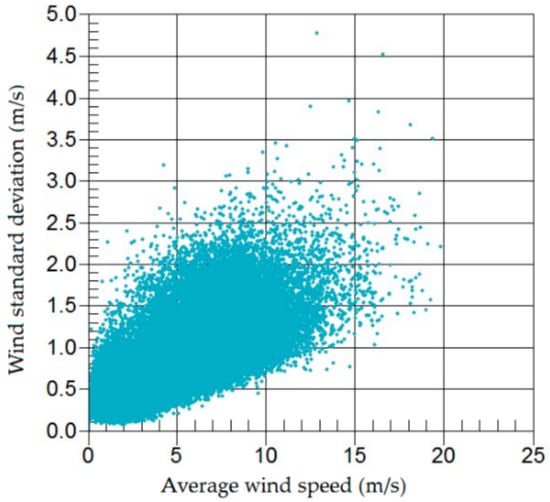
Figure 3.
Standard deviation as a function of average wind speed at 10 m above ground level.
In all wind parks, the relationship between the standard deviation and the average wind speed is proportional, which means that when the average wind speed is increasing, then the standard deviation is increasing as well as shown in Figure 3. Standard deviation plays an important role in the assessment of the uncertainty in the prediction of wind farm energy production, where the relative uncertainty of wind speed is 4%. The energy production in a wind park follows a stochastic principle and requires a statistical analysis in which production estimates should be associated with occurrences probabilities. An uncertainty analysis is often performed as part of a wind farm energy yield assessment.
Figure 4 shows the relationship between the average wind speed and the wind direction. In the wind sectors, WSW and ENE appear the highest average wind speed as well as more frequent data which means the first best sector in energy and time distribution is WSW, while the second best sector in energy is W and the second best sector in time distribution is ENE.
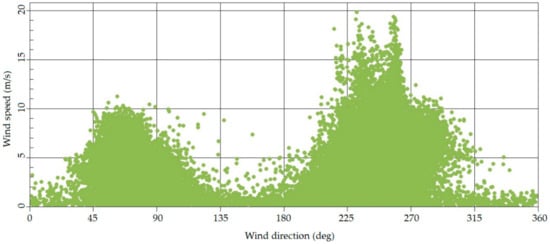
Figure 4.
Wind speed at 10 m agl vs wind direction.
Based on the wind data collected, the annual energy production of each wind park is the total hourly energy production, result of the setting of the data logger, which is usually justified in small periods for avoiding and faults and achieving more accuracy.
Usually, the selected location and hub height, shows the monthly average wind speed for each month of the year and lists the specific month that has the highest monthly value as well as the lowest monthly value, in the calculation of the energy production, avoided any high speed and any very small speed (within the range of the operation speeds of each wind turbine, which is between the speeds cut and the speed in).
Figure 5 shows that the highest average wind speed in KTD wind mast is 6.36 m/s in August while the lowest average wind speed is 3.54 m/s in December.

Figure 5.
Wind speed variation per month.
Figure 6 shows the evaluation of the daily mean wind speed, as well as, the maximum wind speed occurred per day, for the given time-step i.e., if 10 min-series are recorded, the maximum value is of course, not the instantaneous one second gust, but the maximum 10 mins wind speed that occurred during this day.
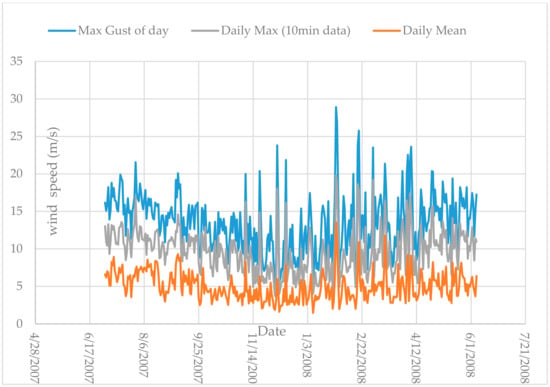
Figure 6.
Wind speed variation per day (mean and max. values).
Figure 7 presents the Diurnal distribution; this is the distribution of the wind speed as a function of the hour of the day.
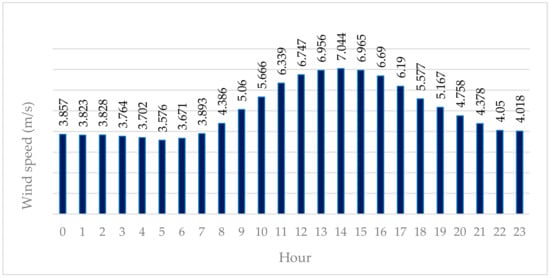
Figure 7.
Distribution of the wind speed per hour of the day.
In this study, there are 52704 data sets available (6 times per hour × 24 h × 366 days) which have been recorded during one leap year. They are represented in 10 min readings. However, the total valid data during the measurement period is lowered to 4,9098 data sets during 340.95 days of the year, while the calm wind speed, measuring less than 2 m/s, is 0%. The missing data in the examined time frame is 3605 samples representing 6.8% from all samples, where all the missing data was in June. Thus. The expected wind turbine energy production based on the available data is 4,234,202 kWh while the calculated annual energy production after correlation is 4,536,933 kWh, where the value of the annual energy production is the projection of the data distributions to 1-year. Figure 8 shows the monthly wind turbine energy before the correlation. The highest energy expected is 587,147 kWh in August while the lowest energy estimation is 89,128 kWh in June.
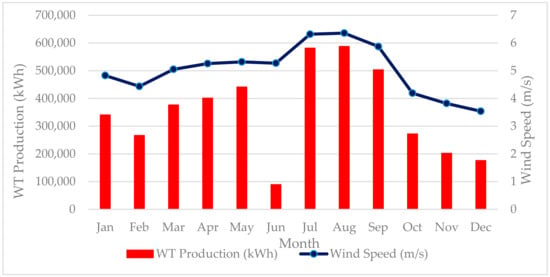
Figure 8.
Mean wind speed per month.
Figure 9 shows the monthly wind turbine energy after the correlation, the highest energy expected is 587,147 kWh in August while the lowest energy estimation is 175,785 kWh in December.
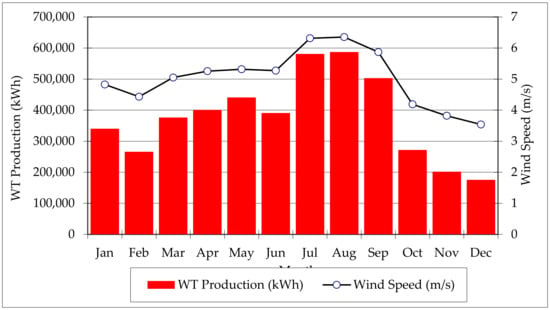
Figure 9.
Mean wind speed per month after correlation.
Figure 10 and Figure 11 show the distribution of the wind based on the energy (not the expected energy production of the wind turbine) as a function of the wind speed (Figure 10) and the wind direction (Figure 11).
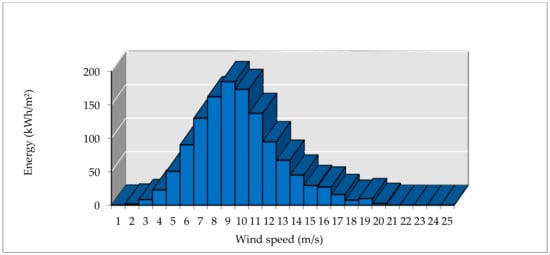
Figure 10.
Energy distribution as a function of wind speed.

Figure 11.
Energy distribution as a function of wind direction.
Figure 12 shows the wind data accumulated probability based on the data distribution, not on the Weibull distribution. It is a useful tool to estimate the percentage of the time that the wind speed exceeds a specific value, i.e., how much of the time the wind speed exceeds the cut-in or the cut off speed of the wind turbine (i.e.,: 2.6% of the time, the wind speed is higher than 10 m/s).
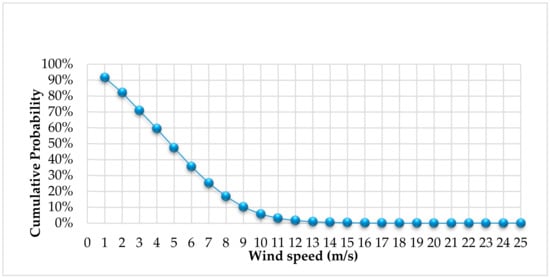
Figure 12.
Cumulative data probability.
For each of the sectors defined in the tool setup, one flow field is calculated. In the sequence, the simulated flow fields are used for the estimation of the energy production from the wind turbines, taking into account the long-term wind speed and direction distribution.
In addition, Figure 13 and Figure 14 show the wind speed at the wind farm vicinity, for 95 m height above ground level (agl) and the power density for the same height in order to take a glance of the wind potential for the location.

Figure 13.
Mean wind speed at KTD site at 95 m above ground level.

Figure 14.
Mean power density at KTD site at 95 m above ground level.
In general, the wind speed over-speed due to the topography is evident in wind directions where the terrain slopes are steep. For each of the sectors defined in the software setup, one flow field is calculated. In the sequence, the simulated flow fields are used for the estimation of the energy production from the wind turbines, taking into account the long-term wind speed and direction distribution.
The site has a maximum height of 1080 m above sea level in a hilly forested area. The results from windfarm show that steepness should not be a great issue with none of the sites having a roughness Rix value greater than 0.2. This makes the development site interesting for analysis in both sets of software as both should be capable of providing interesting results.
5.2. Energy Yield
In Table 5, the energy yield of the wind farm sitting is presented. The main characteristic of the siting is the increased losses due to topography (>32%) as several wind turbines are located at inferior positions. The wake effects are calculated to be 3.11%.

Table 5.
Wind farm energy yield for the wind farm layout.
Figure 15 and Figure 16 show the results of basic and net energy yield with respect to individual unit production and with respect to the wind direction sector, respectively.
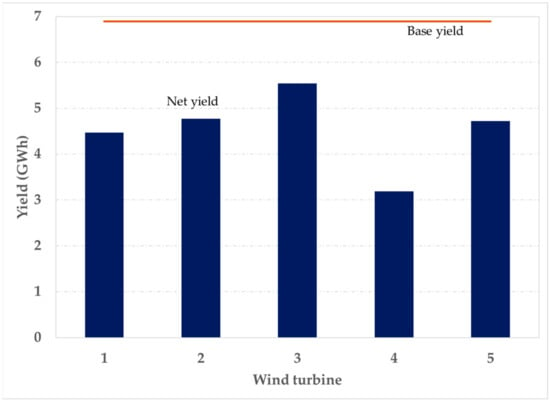
Figure 15.
Basic and net energy yield for each turbine for the initial layout.
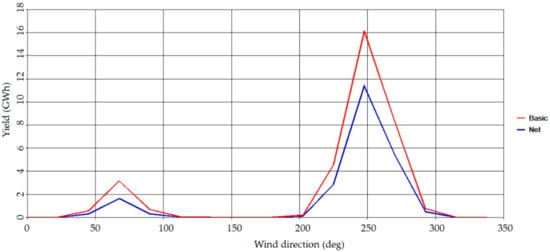
Figure 16.
Basic and net energy yield with wind direction for the initial layout.
The base energy yield is calculated to equal to 34.45 GWh per year, where the topographic affect change is −32.17% and the wake losses are −3.11%. Therefore, the initial KTD’s wind park final energy yield is equal to 22.6541 GWh per year.
The calculations of the hydropower system show that the efficiency of the system is 78.1%. Therefore, the efficiency of the whole hybrid project (wind park and hydropower-pump system) is approximately 40%. The amount of the electricity that can be produced by the KTD’s hybrid system is approximately 26,663,933 kWh/year. The emissions reduction from the operation of this system is estimated to be 15,100,000 tons of CO2-equivalent each year, which is acceptable for our study.
5.3. Economic Results
The results of the Discounted Cash Flow (DCF) financial analysis are illustrated through Table 6. Furthermore, Figure 17 illustrates the cash flow of the project throughout its lifespan for this study.

Table 6.
Financial analysis for KTD’s hybrid system.
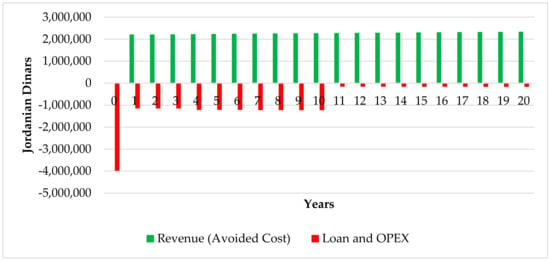
Figure 17.
Cash flow diagram for KTD’s hybrid system.
All estimated values can increase or reduce when the project will become true. This scenario (grant and debt financing) of the study is deemed as feasible. However, there are various parameters and conditions that affect the decision and should be taken in NEPCO’s consideration. These parameters are:
- Availability of the initial percentage of the grant.
- Availability of the lending institute (bank) providing the long-term loan estimated interest rate for the initial cost.
- The technical capability of the technical team in NEPCO to operate and maintain the system.
- Stability of the selling energy price for the entire project lifetime.
- The cost of the spare parts if needed during the lifetime of the project.
6. Conclusions
The increased use of renewable energy systems worldwide during recent decades caused saturation in Jordan electrical grid. The primary cause of this saturation is the intermittent nature of the electrical power produced by these technologies and the subsequent stability issues that the grid operators are faced with. Design, modeling, analysis, and feasibility study of a hybrid wind and water-pumping storage system was performed in this paper. The system was designed and analyzed for King Talal Dam which is in Northern Jordan. The importance of this study is that it is directed mainly to Jordan and the MENA region in general. The Jordanian renewable energy market is a promising arena that encourages developers, investors, engineers and companies to develop and install pure renewable energy systems and renewable energy hybrid projects for the generation of electricity. King Talal Dam power plant is considered of high rated output power relative to Jordan’s power generation plants. It is also considered to have a good level of sustainability due to its significant water level throughout the whole year.
For the project design proposed in this study, water pumped-hydro storage was capable of adjusting the demand supply to balance and consequently reduce the gap between peak and off-peak periods, and play an important role of levelling other power generation plants and stabilizing of the power grid. First, the project allowed an increase in the penetration capacity of renewable energy projects in the grid by providing voltage and frequency stability to support the intermittent nature of such project. During times of low electricity demand, such as at night or on weekends, the excess energy produced by the wind farm is used to pump water to an upper reservoir; the turbine acts as pump moving water back uphill. During periods of high electricity demand, the stored water is released through turbines.
This type of support with the stabilizing features also prevents system blackout during peak demand. Additionally, the pumped-hydro storage portion of the project can be implemented on its own at King Talal Dam, and even replicated in other local dams for the support and stability of the national grid.
Advantages of the project lie in the current restrictions for NEPCO to shut down commercial renewable energy projects that are currently running to maintain the wellbeing of the electric grid. During the forced shut-down period, NEPCO compensates investors for their energy losses, which can be costly. Alternatively, investing in such systems enables renewable energy projects to work all the time without the need to shut down. Finally, the two-way turbine technology can be used by NEPCO as hydroelectric generation when instant additional energy is in demand.
The Voltage and Frequency of NEPCO grid must be kept stable, particularly through the hours of peak load. Pumped-storage plants are used for grid stabilization and to provide grid services such as frequency shifting and voltage stabilization, therefore, this study analyzes the proposed this problem and suggests a pumped-storage system as a solution.
The total used water for irrigation is approximately 400,000 m3 per day except one day per week, based on this study. It was assumed that the unused water for the above day was collected in the lower tank with total capacity more than 1,200,000 m3. The lower tank, filled within three weeks for the first time and this amount is used in the calculation for this project.
The proposed pumped-storage system will have two pumps/turbines. Water will be collected for 30 h and used for two hours per day for both turbines, with energy supplied from the wind park.
Pumped-storage plants are currently commercially integrated within renewable energy production projects, but their benefits of providing flexibility and storage capacity are not specifically remunerated.
Finally, as proved from this study, the proposed hybrid system is considered to be an optimal renewable energy feasible system. It is in this case considered to be a pilot project and not as a 100% renewable energy commercially feasible system. However, it is still a pure and clean energy hybrid wind and pumped-storage system.
Author Contributions
Conceptualization, M.A.-A. and S.A.H.; methodology, M.J. and S.A.H.; software, S.A.H.; formal analysis, M.A.-A. and N.B.; investigation, M.J. and S.A.H.; resources, M.A.-A.; E.A. and N.B.; data curation, M.A.-A. and M.J.; writing—original draft, M.J. and S.A.H.; writing—review and editing, N.B. and E.A.; supervision, M.A.-A. and S.A.H. All authors have read and agreed to the published version of the manuscript.
Funding
This research received no external funding.
Acknowledgments
The authors are grateful for the support of the National Energy Research Center “NERC”/ Royal Scientific Society “RSS”, who were extremely helpful in accomplishing this research paper by providing all required technical data.
Conflicts of Interest
The authors declare no conflict of interest.
References
- Jordanian Ministry of Environment. Jordan’s Third National Communication on Climate Change 2014; Jordanian Ministry of Environment: Amman, Jordan, 2014. Available online: https://unfccc.int/resource/docs/natc/jornc3.pdf (accessed on 15 March 2020).
- Jordanian Ministry of Energy and Mineral Resources. Energy Annual Report in 2016; Jordanian Ministry of Energy and Mineral Resources: Amman, Jordan, 2016. Available online: https://www.greengrowthknowledge.org/sites/default/files/downloads/policy-database/JORDAN%29%20The%20Ministry%20of%20Energy%20and%20Mineral%20Resources%2C%20Annual%20Report%202016.pdf (accessed on 15 March 2020).
- Rehman, S.; Al-Hadhrami, L.M.; Alam, M.M. Pumped Hydro Energy Storage System: A Technological Review. Renew. Sustain. Energy Rev. 2015, 44, 586–598. [Google Scholar] [CrossRef]
- Deane, J.P.; Gallachóir, Ó.B.P.; McKeogh, E.J. Techno-Economic Review of Existing and New Pumped Hydro Energy Storage Plant. Renew. Sustain. Energy Rev. 2010, 14, 1293–1302. [Google Scholar] [CrossRef]
- Ibrahim, H.; Ilinca, A.; Perron, J. Energy Storage Systems—Characteristics and Comparisons. Renew. Sustain. Energy Rev. 2008, 12, 1221–1250. [Google Scholar] [CrossRef]
- Katsaprakakis, D.A.; Christakis, D.G.; Zervos, A.; Papantonis, D.; Voutsinas, S. Pumped Storage Systems Introduction in Isolated Power Production Systems. Renew. Energy 2008, 33, 467–490. [Google Scholar] [CrossRef]
- EIA. Annual Energy Review 2008; Energy Information Administration, Official Energy Statistics from the US Government; EIA: Washington, DC, USA, 2008. Available online: https://www.eia.gov/totalenergy/data/annual/archive/038408.pdf (accessed on 15 March 2020).
- The Federation of Electricity Companies of Japan. (FEPC). Available online: http://www.fepc.or.jp/english/library/electricity_eview_japan/index.html (accessed on 13 March 2020).
- Briongos, F.; Platero, C.A.; Sánchez-Fernández, J.A.; Nicolet, C. Evaluation of the Operating Efficiency of a Hybrid Wind–Hydro Powerplant. Sustainability 2020, 12, 668. [Google Scholar] [CrossRef]
- Li, R.; Wu, B.; Li, X.; Zhou, F.; Li, Y. Design of wind-solar and pumped-storage hybrid power supply system. In Proceedings of the 2010 3rd IEEE International Conference on Computer Science and Information Technology (ICCSIT), Chengdu, China, 9–11 July 2010; Volume 5, pp. 402–405. [Google Scholar]
- Pérez-Díaz, J.I.; Perea, A.; Wilhelmi, J.R. Optimal short-term operation and sizing of pumped storage power plants in systems with high penetration of wind energy. In Proceedings of the 2010 7th International Conference on the European Energy Market (EEM), Madrid, Spain, 23–25 June 2010; pp. 1–6. [Google Scholar]
- Islam, M.R.; Mekhilef, S.; Saidur, R. Progress and recent trends of wind energy technology. Renew. Sustain. Energy Rev. 2013, 21, 456–468. [Google Scholar] [CrossRef]
- Al-Masri, H.M.K.; Al-Quraan, A.; AbuElrub, A.; Ehsani, M. Optimal Coordination of Wind Power and Pumped Hydro Energy Storage. Energies 2019, 12, 4387. [Google Scholar] [CrossRef]
- Bessa, R.; Moreira, C.; Silva, B.; Matos, M. Handling renewable energy variability and uncertainty in power systems operation. Wiley Interdiscip. Rev. Energy Environ. 2014, 3, 156–178. [Google Scholar] [CrossRef]
- Anagnostopoulos, J.S.; Papantonis, D.E. Simulation and size optimization of a pumped–storage power plant for the recovery of wind-farms rejected energy. Renew. Energy 2008, 33, 1685–1694. [Google Scholar] [CrossRef]
- Bueno, C.; Carta, J.A. Wind Powered Pumped Hydro Storage Systems, a Means of Increasing the Penetration of Renewable Energy in the Canary Islands. Renew. Sustain. Energy Rev. 2006, 10, 312–340. [Google Scholar] [CrossRef]
- Papaefthymiou, S.V.; Karamanou, E.G.; Papathanassiou, S.A.; Papadopoulos, M.P. A Wind-Hydro-Pumped Storage Station Leading to High RES Penetration in the Autonomous Island System of Ikaria. IEEE Trans. Sustain. Energy 2010, 1, 163–172. [Google Scholar] [CrossRef]
- Kapsali, M.; Anagnostopoulos, J.S.; Kaldellis, J.K. Wind Powered Pumped-Hydro Storage Systems for Remote Islands: A Complete Sensitivity Analysis Based on Economic Perspectives. Appl. Energy 2012, 99, 430–444. [Google Scholar] [CrossRef]
- Connolly, D.; Lund, H.; Mathiesen, B.V.; Pican, E.; Leahy, M. The Technical and Economic Implications of Integrating Fluctuating Renewable Energy Using Energy Storage. Renew. Energy 2012, 43, 47–60. [Google Scholar] [CrossRef]
- Deshmukh, M.K.; Deshmukh, S.S. Modeling of Hybrid Renewable Energy Systems. Renew. Sustain. Energy Rev. 2008, 12, 235–249. [Google Scholar] [CrossRef]
- Tilahun, M.A. Feasibility Study of Pumped Storage System for Application in Amhara Region, Ethiopia. Master’s Thesis, Department of Energy Technology, Division of Heat and Power Technology, Royal Institute of Technology, Stockholm, Sweden, 2012. [Google Scholar]
- Ma, T.; Yang, H.; Lu, L. Feasibility study and economic analysis of pumped hydro storage and battery storage for a renewable energy powered island. Energy Convers. Manag. 2014, 79, 387–397. [Google Scholar] [CrossRef]
- Al-Addous, M.; Saidan, M.; Bdour, M.; Dalala, Z.; Albatayneh, A.; Class, C.B. Key Aspects and Feasibility Assessment of a Proposed Wind Farm in Jordan. Int. J. Low-Carbon Technol. 2019, 15, 97–105. [Google Scholar] [CrossRef]
- Saidan, M.N.; Drais, A.A.; Al-Manaseer, E. Solid waste composition analysis and recycling evaluation: Zaatari Syrian refugees camp, Jordan. J. Waste Manag. 2017, 61, 58–66. [Google Scholar] [CrossRef] [PubMed]
- Hadadin, N. Dams in Jordan Current and Future Perspective. Can. J. Pure Appl. Sci. 2015, 9, 3279–3290. [Google Scholar]
- Sahil, B.M. Design and Analysis of a Hybrid Power System (Wind-Hydroelectric with Water Pumping Storage). Master Thesis, German Jordanian University, Amman, Jordan, 2018. [Google Scholar]
- WindFarm Version 4; Computer Program; ReSoft Ltd., Chester House: London, UK, 2018.
- Al-Addous, M.; Jaradat, M.; Albatayneh, A.; Wellmann, J.; Al Hmidan, S. The Significance of Wind Turbines Layout Optimization on the Predicted Farm Energy Yield. Atmosphere 2020, 11, 117. [Google Scholar] [CrossRef]
- Kaldellis, J.K. The contribution of small hydro power stations to the electricity generation in Greece: Technical and economic considerations. Energy Policy 2007, 35, 2187–2196. [Google Scholar] [CrossRef]
- Montgomery, D.C. Design and Analysis of Experiments, 8th ed.; Arizona State University John Wiley & Sons, Inc.: Hoboken, NJ, USA, 2012. [Google Scholar]
- Sullivan, W.G.; Wicks, E.M.; Koelling, C.P. Engineering Economy, 16th ed.; Pearson/Prentice Hall: Upper Saddle River, NJ, USA, 2014. [Google Scholar]
© 2020 by the authors. Licensee MDPI, Basel, Switzerland. This article is an open access article distributed under the terms and conditions of the Creative Commons Attribution (CC BY) license (http://creativecommons.org/licenses/by/4.0/).